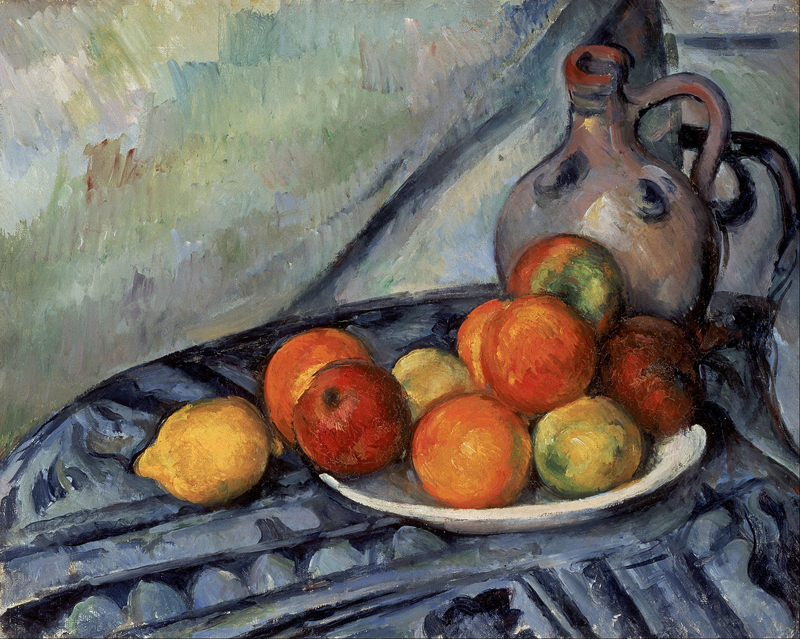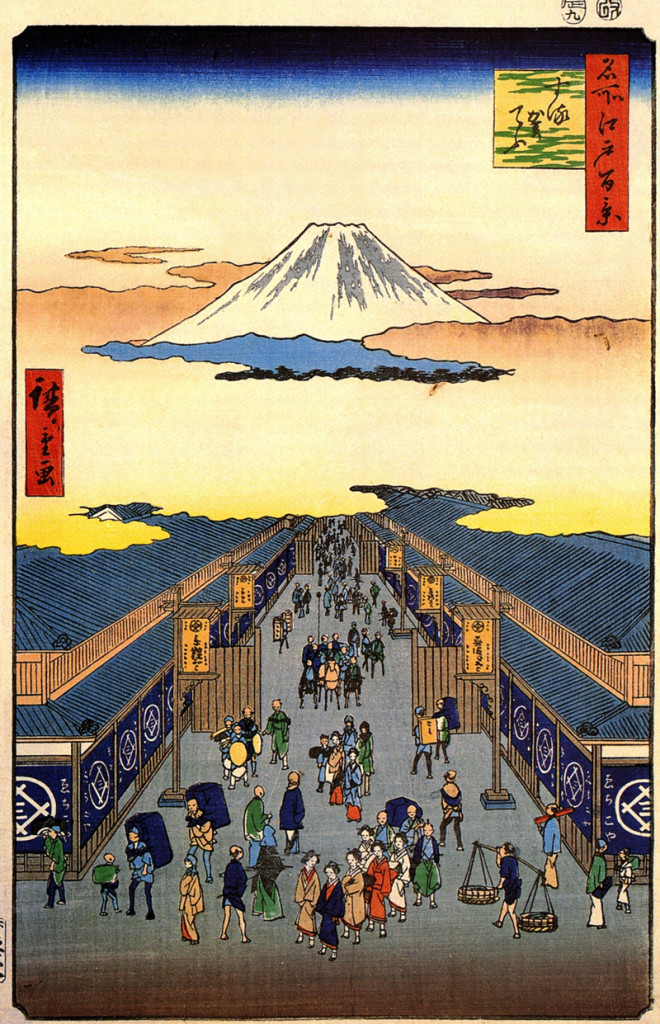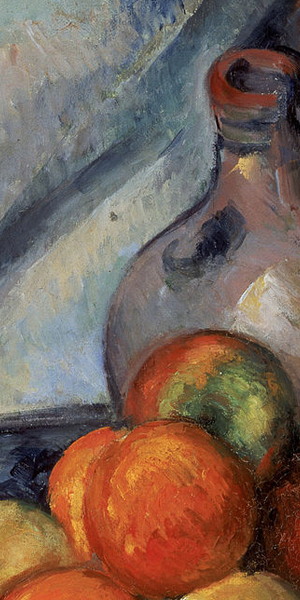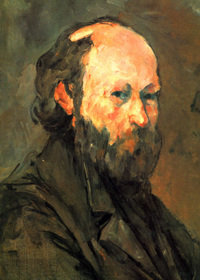
Fruit and a Jug on a Table
Paul Cézanne, French, circa 1890-1894
(oil on canvas)
Museum of Fine Arts, Boston
This is the third and final entry in our discussion on the history of still life.
In the previous entry, we looked at such 17th century vanitas works as Still Life by Van der Ast and Vanitas Still Life by Gijsbrechts. How did the history of still life progress after this period? By the 18th century, still life lost some of its symbolism and largely came to be appreciated for its visual qualities. However, it wasn’t until the late 19th century that still life rose from its lowly status. It was mostly through the work of French artist Paul Cézanne that still life as a subject in Western art rose in status. No longer a facsimile (exact copy) of surfaces, in Cézanne’s capable hands still life becomes a means with which to experience qualities beneath the surface, as we shall see here.
Cézanne spent a large part of his career on still life. You might think Fruit and a Jug on a Table was easy to paint. However, the work is deceptively simple. One can imagine Cézanne sitting at the table, looking down and moving the objects around, meticulously arranging everything to create his composition. Every stroke has been carefully calibrated to every other stroke, resulting in a composition of near perfection. Cézanne constructed form and volume using color alone—he did not model his shapes by shading with lighter to darker values to create a sense of 3D. Instead, he used brushstrokes in dense combinations of opaque paint in a narrow spectrum of colors. Blue, black and gray tones that make up the tablecloth contrast with the red, yellow and orange tones that make up the fruit. Yellows, oranges, reds and greens reflect across and seemingly melt into the flesh of the fruit and in more softened shades penetrate the surface of the jug. Remove any one color, and the structure of the fruit, I dare say the very atoms that hold them together, will fall apart.
Cézanne recognized a universal geometry fundamental to all objects, claiming that nature could be understood as a construction of three basic shapes: the cylinder, sphere and cone. The fruit and white plate and jug on the tabletop and the caned chair behind the table on the right are constructed of these basic shapes. While Cézanne used color to build up form, he also used color to create perspective. How so? No longer are we looking as if through a window at a space that recedes via some mathematically constructed vanishing point in the distance. Instead, we are looking at a scene that is nearly flat. Do you know what a vanishing point is? In the 1400s in Italy, during the time of the Renaissance, linear perspective was used by artists in their designs. The ancient Greeks and Romans may have understood linear perspective too, but knowledge of it was lost in the Middle Ages. Correct one-point linear perspective occurs when the diagonal lines in a composition converge in a single vanishing point in the distance. Here is one example of vanishing point perspective.

Suruga-cho, No. 8, One Hundred Famous Views of Edo
Hiroshige, Japanese, 1856
(color wood-cut)
British Museum, London
In this print, the Japanese print artist Utagawa Hiroshige has given the viewer an exaggerated western style perspective, in which the diagonal compositional lines converge in a single vanishing point in the distance. One’s eye naturally travels along these converging compositional lines and rests upon the imposing image of Mount Fuji, which rises up majestically and reflects the brilliant rays of the sun. This strict symmetry is softened by the irregular cloud formations that surround the great mountain. The design of these clouds is a traditional device used in Japanese paintings to separate narrative scenes in a work. Below the mountain runs Suruga-cho, Suruga Street in English, which provides the vanishing point perspective. Along Suruga Street lies Japan’s premier store, Echigoya, now called Mitsukoshi Department Store, a venerated landmark. The store is identified by its crest, a circle around the characters for “three” and “well,” which when read together spell out the short form of its name—Mitsui.

Close-up of Fruit and a Jug on a Table
In contrast, Fruit and a Jug on a Table doesn’t have linear perspective. Instead, the scene is nearly flat. Do you see how the composition is flattened and tilted downward? Look at the tabletop. It inhabits a space that is flat and tilted. However, Cézanne’s composition is not entirely flat. There is some depth in his work. How did the artist create depth in his painting? Via color, of course! Cézanne relied on the effect of contrasting the reds and oranges and yellows which appear to pop forward with the blues and grays which appear to fall backward. Look closely. Can you see how the contrast between the colors of the fruit and the colors of the tablecloth create a kind of shift in perspective?
At first, many people didn’t like Cézanne’s work. They thought it was too messy. They didn’t like the fact that it was no longer an exact copy of nature. They also didn’t like the flattened perspective. You can’t tell, but this painting is rather small. Even so, the fruit appear weighty in their concentration of volume and warm tones. Essentially, Cézanne did not trick the eye to report what was real on the surface but rather to report what was real underneath. Indeed, when one looks at the fruit in his work, one feels what is essential about them. One feels their very substance and nature and forgets their names. The fact that Cézanne’s painting is no longer a copy of the surface of nature but is a rendering of what lies below the surface was revolutionary and set a new path for modern artists that followed him in the 20th century.
All of this brings us to Sam Taylor-Wood’s contemporary work of art called Still Life. Artists today are well studied in the history of art, and we can see this here. Sam Taylor-Wood follows the tradition of vanitas still life paintings by earlier artists like the work by Van der Ast in the previous entry. Like Van der Ast’s painting, here we have a darkened background with illuminated still life objects in the foreground. However, instead of paint on panel or canvas, we have a video and the element of time. Like Van der Ast’s painting, the video begins with a view of a wooden table, upon which there is a woven plate of fresh and luscious apples, peaches and pears. As the video unfolds, however, things quickly devolve. Soon, very fine, fluffy white threads of mold envelop the fruit. As the mold begins to take over the fruit, fruit flies swarm and each piece of fruit decomposes. In the end, all that remains is a collapsed gray mass. The artist photographed her plate of fruit in a controlled environment over a period of time. She then compressed the time span into a matter of minutes. Her end result was a work of art that reminds us of age-old vanitas themes but with a modern twist.
Is there any object in the video that remains for the duration unchanged? To the right and in front of the plate of fruit there is a blue plastic pen. While the fruit quickly decays, the pen remains still—besides the woven plate, the only still life object in the video for that matter. Why do you think the artist included a pen in her work? Perhaps she included a pen to mimic objects that earlier vanitas artists would include in their works to create the illusion of three-dimensional space. Remember the cut carnation and multicolored tulip in Van der Ast’s painting and the red maulstick in Gijsbrechts’ painting? Those objects were positioned in such a way as to create a sense of depth backward into the picture plane. However, perhaps for Taylor-Wood the pen is a comment on our environment and the nature of modern materials that will remain long after we are gone. It may just be me, but as I watch the decomposition of this plate of fruit, I end up pondering the very fragility of the earth itself!
Let’s conclude our discussion on the history of still life with one last inquiry. After all, this wouldn’t be Art Makes You Smart if I didn’t make some connection to science or literature or math or social studies. Sam Taylor Wood’s video makes an apt connection to science. It records the development of mold upon organic matter. What can you tell me about molds? Molds require moisture for growth. What exactly are molds? Molds are a type of fungi. Like all fungi, molds derive energy not through photosynthesis but from the organic matter on which they live. Molds appear like very fine, fluffy white threads over the surface. Typically, molds secrete enzymes. These enzymes degrade substances such as starch and cellulose into simpler substances which can be absorbed. In this way molds play a major role in causing decomposition of organic material, enabling the recycling of nutrients throughout ecosystems. In conclusion, Sam Taylor-Wood’s video should remind us of a cycle that at its core is the very basis of life!
§
Would you like to see Cézanne’s Fruit and a Jug on a Table and Sam Taylor-Wood’s Still Life in person? All you have to do is visit the Museum of Fine Arts (MFA) in Boston, Massachusetts. I’m sure someone at the MFA in Boston will point you in the right direction. If you would like to see Hiroshige’s print Suruga-cho, No. 8, you can visit the British Museum in London, England. Or perhaps you can visit one of the many other museums around the world that have Hiroshige’s prints in their collections. Check on-line to find out where they are. You can even arrange to have a tour with a docent. Whether you visit a museum on your own or have a tour with a docent, it will be well worth your time!
